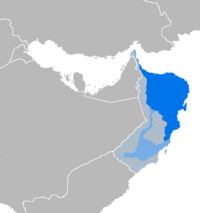Tefrian
This article is private. The author requests that you do not make changes to this project without approval. By all means, please help fix spelling, grammar and organisation problems, thank you. |
This article is a construction site. This project is currently undergoing significant construction and/or revamp. By all means, take a look around, thank you. |
| Tefrian | |
|---|---|
| پریشحشر Prayešeḥšur | |
 Flag of the Shardarate of Tefria | |
| Pronunciation | [ˈpʰɾäɪ̯(ə)ʃəħˌʃʉɾ] |
| Created by | Vrianne |
| Date | 2024 |
| Setting | Earth |
| Native to | Tefria |
| Ethnicity | Tefrian |
| Native speakers | 3.4 million ({{{date}}}) |
Asisic
| |
Early forms | Proto-Asisic
|
Map of areas where Tefrian is spoken
...as a majority language
...as a minority language
...as the language of law and government | |
Tefrian (/təˈfɹiːən/ tə-ꜰʀᴇᴇ-ən), natively called دلسان پریشحشر (di'lisān Prayešeḥšur [dəlɪˈsaːn ˈpʰɾäɪ̯(ə)ʃəħˌʃʉɾ]), is a West-Asisic belonging to the Asisic language family. It is, excluding diaspora, spoken entirely within Shardarate of Tefria, wherein it is recognized as the sole official language. It is the most spoken and most influential West-Asisic language, with about 3 million native speakers.
Classification
Name
History
Old Tefrian
Modern Tefrian
Phonology
Vowels
The Standardized Variety of Tefrian has 9 unique monophthongs, 5 diphthongs, and 5 triphthongs.
| Short | Long | |||||||
|---|---|---|---|---|---|---|---|---|
| Front | Central | Back | Front | Central | Back | |||
| unrounded | rounded | |||||||
| Close | i ◌ِ | ʉ ◌ُ | o̞ ~ u ◌ُ | iː ی | yː ۆ | uː و | ||
| Mid | e̞ ◌ِ | |||||||
| Open | a ◌َ | aː ا | ||||||
| -ɪ̯ | -ʊ̯ | -ʊ̯̃ | -ɪ̯e | -ʊ̯e | |
|---|---|---|---|---|---|
| a- | aɪ̯ ـَی | aʊ̯ ـَو | ãʊ̯̃ اً | aɪ̯e ـَیِ | aʊ̯e ـَوِ |
| e- | ẽʊ̯̃ ◌ٍ | eɪ̯e ـِیِ | |||
| o- | õʊ̯̃ ◌ٌ | oʊ̯e ـُوِ | |||
| ø- | øʏ̯e ـُۆِ |
Notes:
- /i/ is near-close [ɪ] except in word-final open syllables.
- Urban speakers pronounce /ʉ/ as near-close [ʏ] while rural speakers pronounce it as central [ʉ] or [ɨ].
- Older rural speakers may distinguish between 2 close central vowels (such as [ɨ] and [ʉ]) which have merged for the majority of other speakers, including in the standard language.
- /a/ is central [ä] but colored to [ɑ] by uvular and pharyngealized consonants.
- The vast majority have weakened the final /-e/ element of triphthongs to [-ə̆] or even dropped it completely.
- Rural speakers tend to monophthongize /øʏ̯e/ to [ø̞ː].
Consonants
The Standardized Variety of Tefrian has 30 unique consonants. Tefrian's is one of the only two West Asisic languages to retain pharyngeal and pharyngealized consonants, making its phonology semitic-like at face value.
| Labial | Alveolar | Post-alveolar | Velar | Uvular | Pharyngeal | Glottal | ||||
|---|---|---|---|---|---|---|---|---|---|---|
| plain | emphatic | plain | emphatic | |||||||
| Nasal | m م | n ن | ||||||||
| Plosive | voiceless | p پ | t ت | tˤ ط | t͡ʃ چ | k ک | q ق | ʔ ء | ||
| voiced | b ب | d د | (dˤ) | d͡ʒ ج | ɡ گ | |||||
| Fricative | voiceless | f ف | s س, ث | sˤ ص | ʃ ش | ʃˤ ض | x ~ χ خ | ħ ح | h ه | |
| voiced | v ڤ | z ز, ذ | zˤ ظ | ʒ ژ | ɣ~ ʁ غ | ʕ ع | ||||
| Rhotic | r ر | |||||||||
| Approximant | l ل | j ی | ||||||||
Notes:
- /b d͡ʒ ʔ sˤ zˤ x ɣ/ occur only in loanwords.
- /p t k/ are aspirated [pʰ tʰ kʰ], while /q/ is tenuis [q]. Some speakers, particularly in the Southwest, may also pronounce /p/ as tenuis [p].
- /dˤ/ is a quite common allophonic realization of /d/ near uvular and pharyngealized consonants.
- /d͡ʒ/ and /ʒ/ tend to be in free variation, with /d͡ʒ/ occurring in syllable-initial stressed positions and /ʒ/ occurring otherwise. Neutralization of /t͡ʃ/ and /ʃ/ in a similar fashion is also apparent in eastern urban speakers.
- /r/ is pronounced as a tap /ɾ/ when not geminated.
Orthography
Grammar
Tefrian is a fusional language, meaning that it utilizes single inflectional morphemes to denote multiple grammatical, syntactic, or semantic features. The vast majority of Tefrian derivational and inflectional morphology relies on suffixation, with very few prefixes in between. Verbs are marked for person, number, tense, and mood (resulting in up to 36 conjugated forms per verb). Nouns exhibit a system of animacy, which is reflect in pluralization and pronoun agreement. Nouns are also marked for 2 numbers.
Word Order
Standard Tefrian has standard subject-object-verb (SOV) word order, with verbs typically being at the very end of a sentence or clause.
- طو شفر زسوعم — ṭaw šufr zesaweˤem — "I saw that book"
The subordinate clauses precedes the main clause, beginning with either a conjunction or a relative pronoun.
- یر ضیفڔ حۆ اچلد ادم زچیدم — Yer ċayfeṛ ḥöwe icild edem zecīdem — "My father told me that guests are coming today"
Yes-no questions are structured the same way as non-interrogative sentences. Interrogative sentences with interrogative pronouns place the interrogative pronoun in the object position.
- قد ارد؟ — Qod ered? — "What is he eating?"
- اش ارد؟ — Uš ered? — "Who is eating?"
Nouns
Like other West-Asisic languages, all Tefrian nouns are grammatically classified as either animate or inanimate. Animacy is inherent to a word and is only indicated in the plurals of regular nouns. Neither verbs nor adjectives display animacy agreement with nouns. Nouns only change for number, as they are not marked for case.
Plural
A given noun is grouped into one of three categories depending on how its plural is formed:
- Regular animate nouns, which regularly form their plurals with the ـڔ -(e)ṛ suffix.
- Regular inanimate nouns, which regularly form their plurals with the ـݦ -(e)ṃ suffix.
- Irregular nouns, which could be either animate or inanimate, and form their plurals by changing the root itself.
| singular | plural | ||
|---|---|---|---|
| regular | animate | دیڤ dayev "sister" |
دیڤڔ dayeveṛ "sisters" |
| inanimate | گشر gušir "island" |
گشرݦ gušreṃ "islands" | |
| irregular | ڤر vir "man" |
ڤر veyeˤ "men" | |
| ارض eraċ "land" |
اراض erāċ "lands" | ||
Pronouns
Tefrian is a pro-drop language, meaning subjective personal pronouns are normally omitted. Tefrian Pronouns come in three forms:
- Direct or Full, which are idependent standalone pronouns.
- Reflexive, which are used in reflexive senses.
- Clitics, which are used when the antecedent is the object or possessor.
| singular | plural | ||||||
|---|---|---|---|---|---|---|---|
| 1st | 2nd | 3rd animate | 3rd inanimate | 1st | 2nd | 3rd | |
| direct | چی cay | طا ṭā | سو saw | طو ṭaw' | ڤی vī | طار ṭār | طور ṭawer |
| reflexive | چم cim | طش ṭiš | سد sod | طد ṭod | ڤن vin | حر ḥer | طلد ṭold |
| clitic | ـم -(e)m | ـش -(e)š | ـد -(e)d | ـن -(e)n | ـر -(e)r | ـلد -(e)ld | |
| singular | plural | ||
|---|---|---|---|
| animate | inanimate | ||
| direct | ير yer | يم yem' | يس yes |
| reflexive | سس sis | سس ses | |
| clitic | ـ(ـڤـ)ـر -(v)ir | ||
| singular | plural | ||
|---|---|---|---|
| animate | inanimate | ||
| direct | اش uš | قد qod' | حر ḥor |
| reflexive | قح qoḥ | حح ḥoḥ | |
| clitic | ـ(ـڤـ)ـح -(v)oḥ | ||
3rd-person pronouns also double as demonstratives.
- طو شفر — ṭaw šufr — "this/that book"


